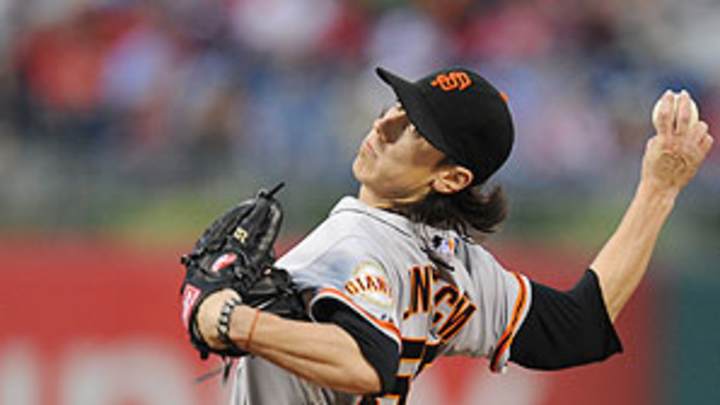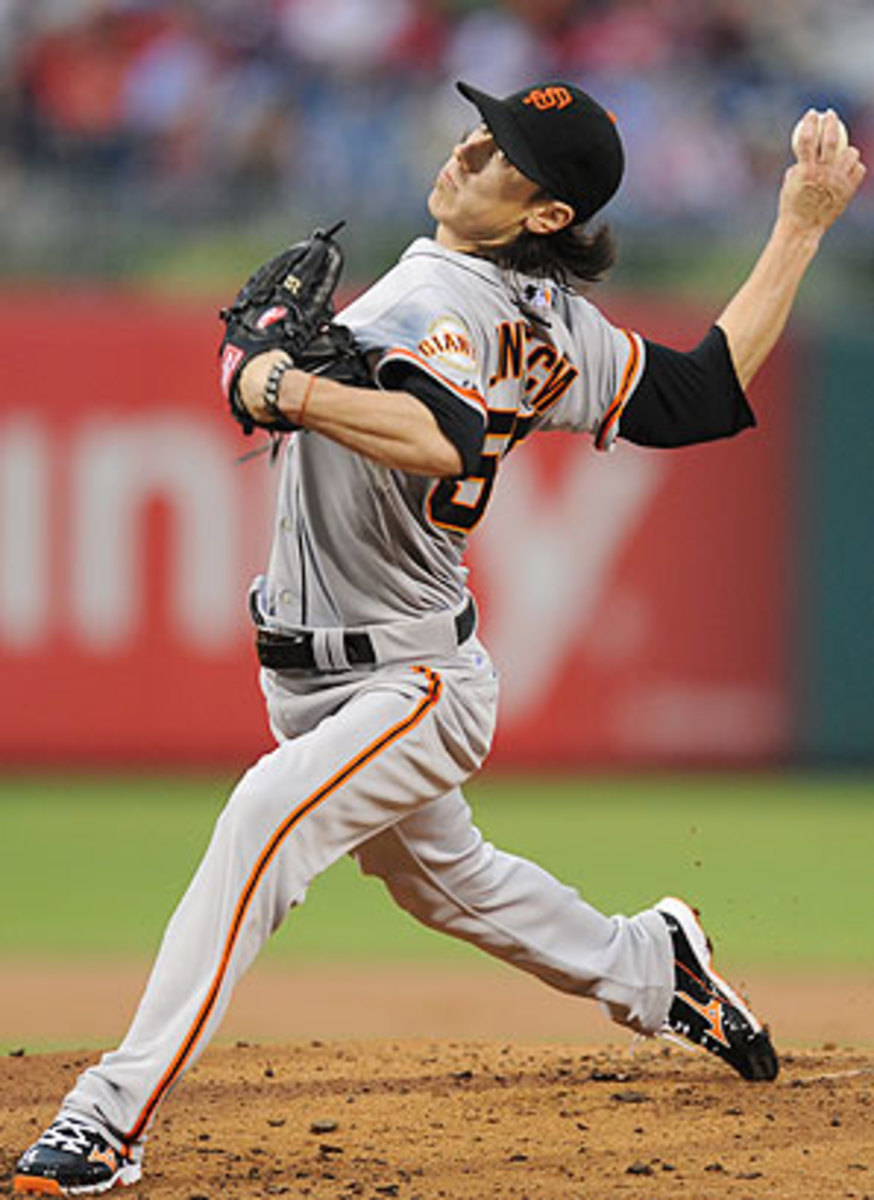Is Lincecum's decline reversible?

The velocity of Tim Lincecum's fastball has dipped about two miles per hour since last year. (Miles Kennedy/Philadelphia Phillies/Getty Images)

The Giants may have lost Melky Cabrera for the season due to the most harebrained steroid scheme ever to surface, but that hasn't stopped them from retaking first place in the NL West by winning four out of six, including two out of three from the Dodgers in Los Angeles. On Tuesday night, they beat L.A. behind a relatively strong showing from Tim Lincecum, who yielded one run and four hits over 5 2/3 innings. The two-time Cy Young winner didn't allow a baserunner until the fourth inning, when Adam Kennedy singled before being erased in a double play, and faced just one over the minimum through five innings after a Hanley Ramirez double went for naught. He unraveled in the sixth -- via a walk and three singles -- but the damage was limited to one run thanks to Angel Pagan throwing out A.J. Ellis at the plate. After a Matt Kemp sacrifice fly, Jose Mijares came on in relief to strike out Andre Ethier, escaping with a 4-1 lead that held up the rest of the way.
It's been an up and down season for Lincecum, who has done more to keep the NL West race close -- in the wrong way -- than any other Giant. According to Baseball-Reference.com's version of Wins Above Replacement Player, his −1.6 WAR is the lowest on the team, well below departed infielder Manny Burriss (-1.0) and mop-and-bucket reliever Brad Penny (-0.8). Though he has continued to strike out more than a batter per inning, the 28-year-old righty has been lit for a 5.30 ERA while walking 4.1 per nine -- both career worsts, by far -- and he hasn't been helped much by his defense, leading to a .333 batting average on balls in play. The velocity of his fastball is down by about two miles per hour relative to last year, and by his own admission he has lost strength due to what he now believes was an overly aggressive weight loss effort.
Even so, Lincecum appears to be making incremental progress toward recovering his old form. Through the first half of the season, he put up a monstrous 6.42 ERA as he struggled both with his control (4.7 walks per nine) and his ability to keep the ball in the park (1.0 homers per nine, up from his previous career mark of 0.6). But just when it looked as though he needed a trip to the bullpen to iron out his complex delivery and reset his mental approach, he began rounding into form. He threw eight scoreless innings while striking out a season-high 11 against the Astros on July 14, then followed that with four more quality starts out of five, albeit against similarly weak competition -- the Phillies, Padres, Mets and Rockies (twice), none of them above .500. He was roughed up by the Nationals last week, departing after allowing four innings and four runs, but Tuesday night's performance suggested he's back on track. In all, his second half numbers -- a 3.30 ERA, 3.1 walks per nine, 0.8 homers per nine -- are right around his final 2010 line, which broke his Cy Young string but didn't result in the end of his time as a frontline pitcher.
If Lincecum were to match his second-half performance over the remainder of the season in terms of innings and earned runs allowed, he would finish with a 4.87 ERA, nearly two full runs higher than the 2.98 mark he compiled from 2007 through 2011. He would also finish with about 30 fewer innings than he has averaged over the course of his full 2008-2011 seasons. That's an alarming drop-off for a pitcher who, at age 28, doesn't seem that old, but according to the work on pitcher aging done by FanGraphs' Bill Petti and Jeff Zimmerman, is right at a point where pitchers' performance falls off with increasing rapidity. Velocity, which tends to peak around age 21, generally declines gently from 25 to 27, but more sharply beyond that. Strikeout, walk and home run rates -- the areas over which a pitcher has most control -- move in the wrong directions with increasing speed as a pitcher heads into his late 20s, as does his Fielding Independent Pitching mark, an ERA estimate founded in those categories. BABIP tends to increase almost in lockstep with home run rate from the late 20s onward as well.
Still, Lincecum's performance would appear to be deteriorating at a more rapid pace than most. To see how common such a scenario is among elite pitchers, I dug into the Baseball-Reference Play Index in search of hurlers who 1) threw at least 1000 innings through their age 27 seasons; 2) had an ERA+ of at least 110 in that span (an ERA 10 percent better than the park-adjusted league average); 3) had strikeout rates of at least 7.0 per nine; and 4) pitched after 1964. I initially wanted to avoid pitchers who worked in the depressed offensive levels of the mid-to-late 1960s, but a prominent one, Steve Carlton, showed up in my results even after I set a 1969 cutoff, so I worked backwards to incorporate the entirety of his career, which began in 1965.
I found 29 pitchers who fit the bill, including five Hall of Famers (Bert Blyleven, Carlton, Fergie Jenkins, Nolan Ryan, and Tom Seaver), two others with strong cases (Roger Clemens and Pedro Martinez), and some notorious flameouts (Dwight Gooden, Sam McDowell, Fernando Valenzuela and Kerry Wood). Because strikeout rates have continued to climb over time -- and have done so with increasing speed recently -- more than half of the set consisted of active hurlers. Among them, 26-year-old Felix Hernandez and 27-year-olds Chad Billingsley and Matt Cain were eliminated from the study, as they had no future performances to provide contrast.
I then examined what the remaining 26 pitchers did in their age 28 seasons, and found that none had fallen off the table to the same extent as Lincecum:
Player | IP | SO/9 | ERA+ | Age 28 Year | IP | SO/9 | ERA+ |
|---|---|---|---|---|---|---|---|
Tim Lincecum | 1028.0 | 9.87 | 137 | 2012 | 140.3 | 9.43 | 65 |
Steve Carlton | 1611.7 | 7.04 | 124 | 1973 | 293.3 | 6.84 | 97 |
Kevin Millwood | 1004.3 | 7.53 | 117 | 2003 | 222.0 | 6.85 | 99 |
Fernando Valenzuela | 1948.0 | 7.06 | 112 | 1989 | 196.7 | 5.31 | 100 |
Nolan Ryan | 1452.7 | 9.74 | 112 | 1975 | 198.0 | 8.45 | 102 |
1279.7 | 7.96 | 114 | 2012 | 155.0 | 8.71 | 102 | |
Kerry Wood | 1043.0 | 10.43 | 118 | 2005 | 66.0 | 10.50 | 105 |
Mario Soto | 1250.0 | 8.09 | 115 | 1985 | 256.7 | 7.50 | 105 |
Bert Blyleven | 2387.3 | 7.20 | 132 | 1979 | 237.3 | 6.52 | 108 |
Sam McDowell | 1562.7 | 9.51 | 128 | 1971 | 214.7 | 8.05 | 113 |
Jake Peavy | 1261.0 | 8.96 | 121 | 2009 | 101.7 | 9.73 | 115 |
Josh Beckett | 1014.3 | 8.51 | 116 | 2008 | 174.3 | 8.88 | 115 |
Barry Zito | 1209.3 | 7.03 | 127 | 2006 | 221.0 | 6.15 | 116 |
Ben Sheets | 1088.3 | 7.79 | 112 | 2007 | 141.3 | 6.75 | 116 |
Dwight Gooden | 1919.7 | 7.90 | 119 | 1993 | 208.7 | 6.43 | 116 |
Carlos Zambrano | 1382.0 | 7.63 | 128 | 2009 | 169.3 | 8.08 | 118 |
1089.7 | 9.47 | 144 | 2007 | 219.0 | 9.66 | 129 | |
1659.3 | 7.56 | 120 | 2009 | 230.0 | 7.71 | 137 | |
1161.3 | 8.45 | 125 | 2012 | 171.3 | 8.83 | 137 | |
Kevin Appier | 1218.3 | 7.10 | 136 | 1996 | 211.3 | 8.82 | 137 |
Fergie Jenkins | 1418.3 | 7.63 | 125 | 1971 | 325.0 | 7.28 | 141 |
Jose Rijo | 1287.3 | 7.66 | 117 | 1993 | 257.3 | 7.94 | 162 |
Roger Clemens | 1513.0 | 8.47 | 146 | 1991 | 271.3 | 7.99 | 165 |
1064.3 | 8.16 | 117 | 2011 | 251.0 | 8.96 | 172 | |
Tom Seaver | 1641.3 | 7.70 | 143 | 1973 | 290.0 | 7.79 | 175 |
Pedro Martinez | 1359.3 | 10.16 | 156 | 2000 | 217.0 | 11.78 | 291 |
In terms of ERA+, an admittedly crude single-season metric given the extent to which a pitcher's ERA can be distorted by things over which he has less control, 16 of the 26 fell off relative to their earlier seasons. Six of them did so by at least 15 percent relative to the league — Santana, McDowell, Millwood, Blyleven, Carlton and Lincecum — but only the latter did so by more than 30 percent. Meanwhile, seven pitchers improved by at least 15 percent relative to the league, including Martinez, who put up one of the greatest seasons of any pitcher in baseball history. Lincecum's season is an outlier in the opposite direction, and while he has a chance to improve his standing incrementally over the season's final six weeks, barring a young-Lincecum caliber run, he'll still wind up the worst by a wide margin.
Beyond the one-year picture, things are at least somewhat more encouraging. Of the other 25 pitchers in this quick-and-dirty study, just four of them had an ERA+ worse than the league average (100) over the remainder of their careers: Valenzuela (91), Soto (92), McDowell (95) and Zito (95, and still active). The 13 pitchers who are no longer active averaged 2,010 more innings and a 116 ERA+ the rest of the way, with four of the Hall of Famers (all except Blyleven) and Clemens each adding another 3,000+ innings. McDowell, Soto and Rijo were the only ones to total fewer than 800 remaining innings. Of the five other pitchers who declined by at least 15 percent relative to the league in their age 28 seasons, Santana (128 ERA+), Carlton (112) and Blyleven (108) snapped out of their funks to remain above-aveage pitchers, while Millwood (100) maintained a league-average career, with only McDowell (95) continuing to tail off.
One can draw conclusions from this study both from a glass-half-full-perspective, and a glass-half-empty one. On the positive side, history suggests that this may be just a bump in the road for Lincecum. Given his accomplishments to date, the odds are that he will rebound to be an above-average pitcher with a substantial portion of his career still ahead of him, though obviously, a career-altering injury remains a possibility for him as much as any pitcher. On the negative side, none of the other pitchers experienced as steep a fall-off as Lincecum, so the pattern may not apply. Furthermore, 20 out of the other 25 pitchers weren't (or haven't been) able to match their pre-age-28 levels (in terms of ERA+) over the remainder of their careers. Of the ones who did, the jury remains out on the active Sheets, Hamels, Sabathia and Verlander, while Rijo's remaining career was relatively short (592 2/3 innings).
